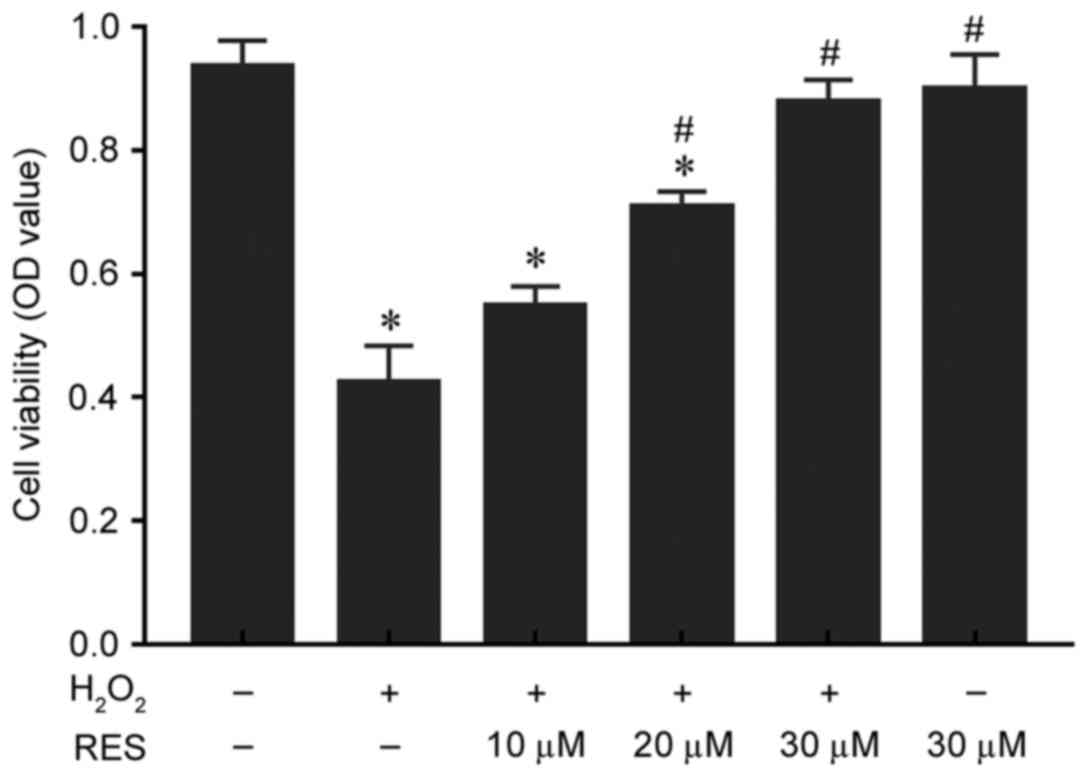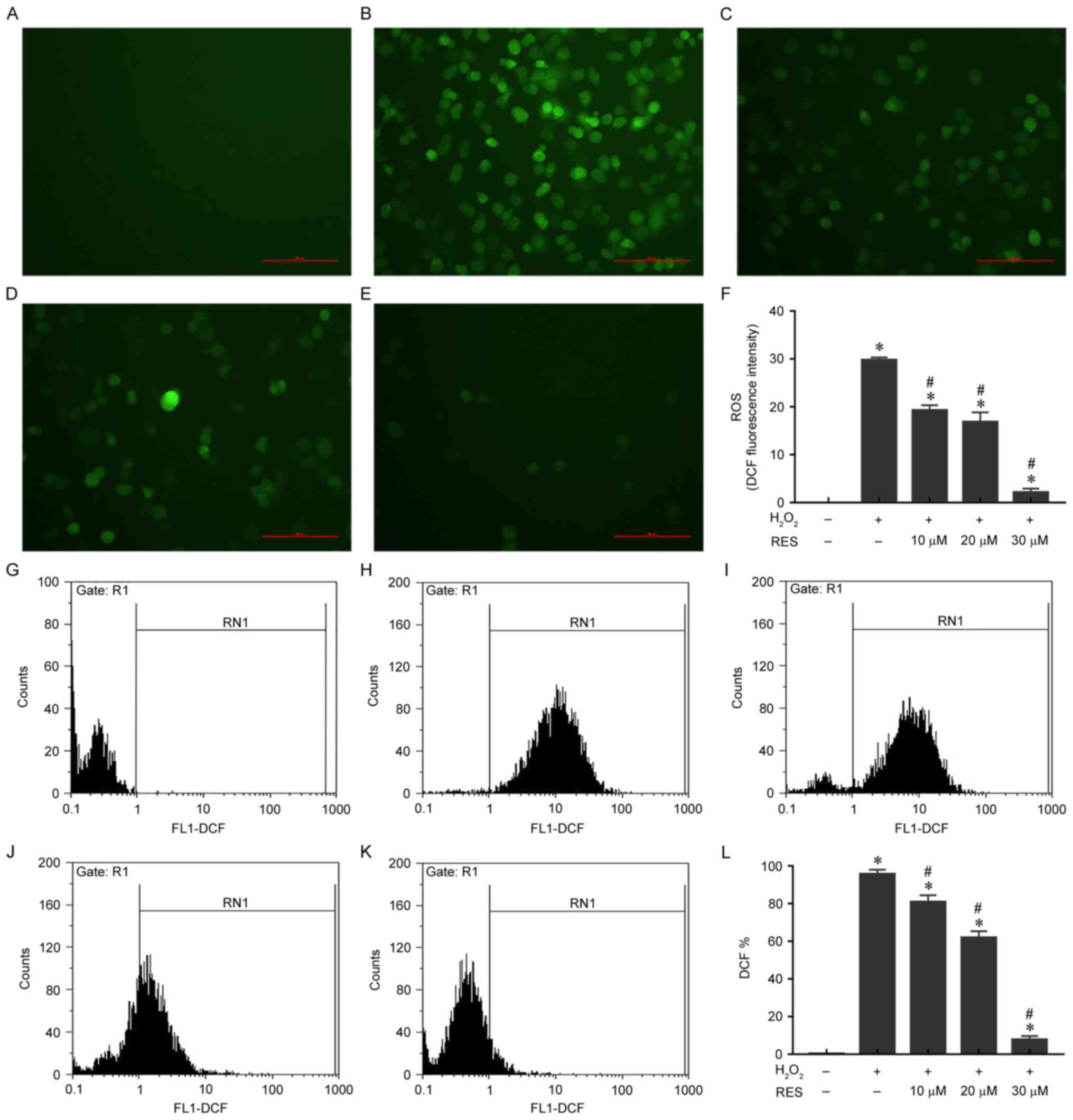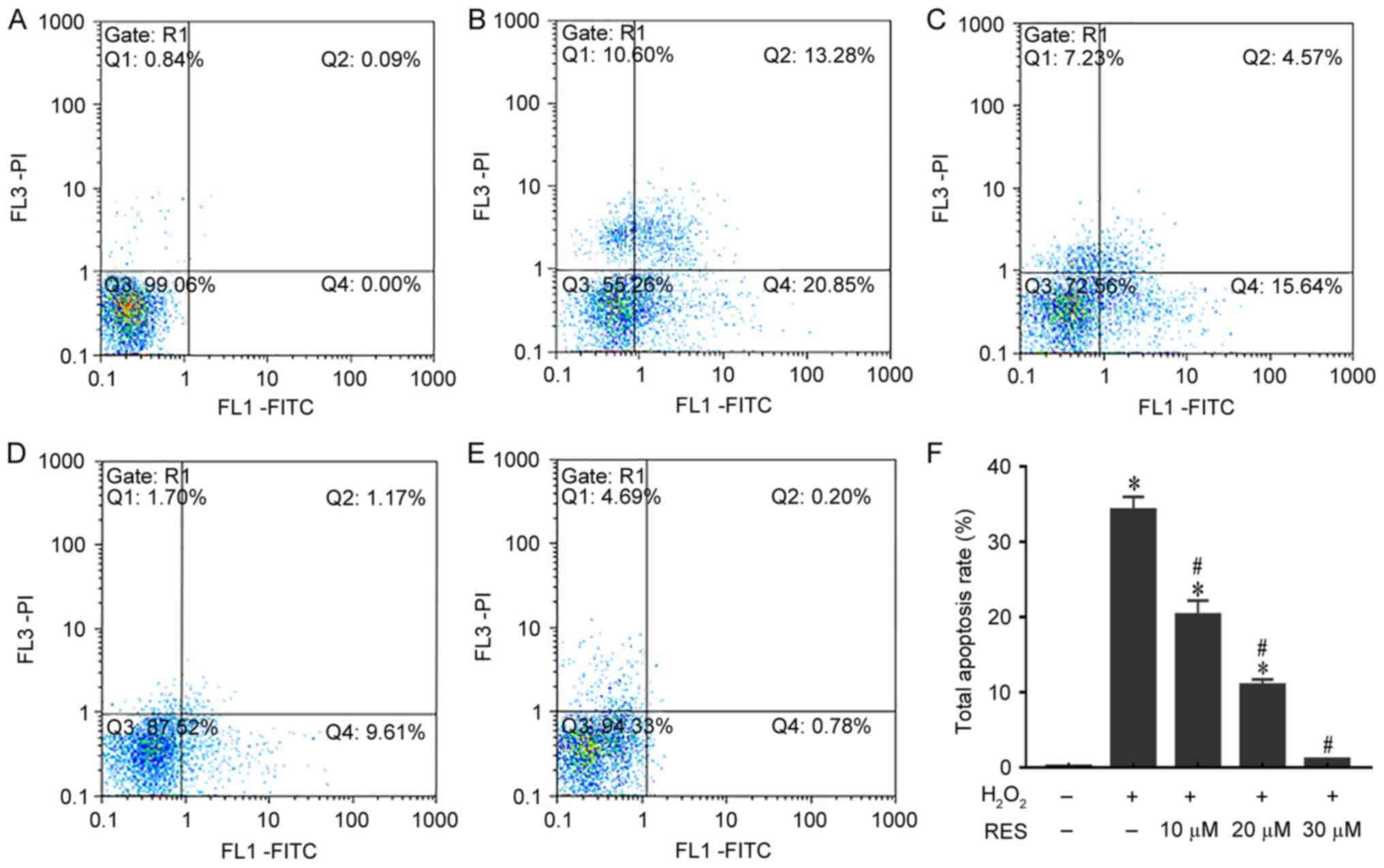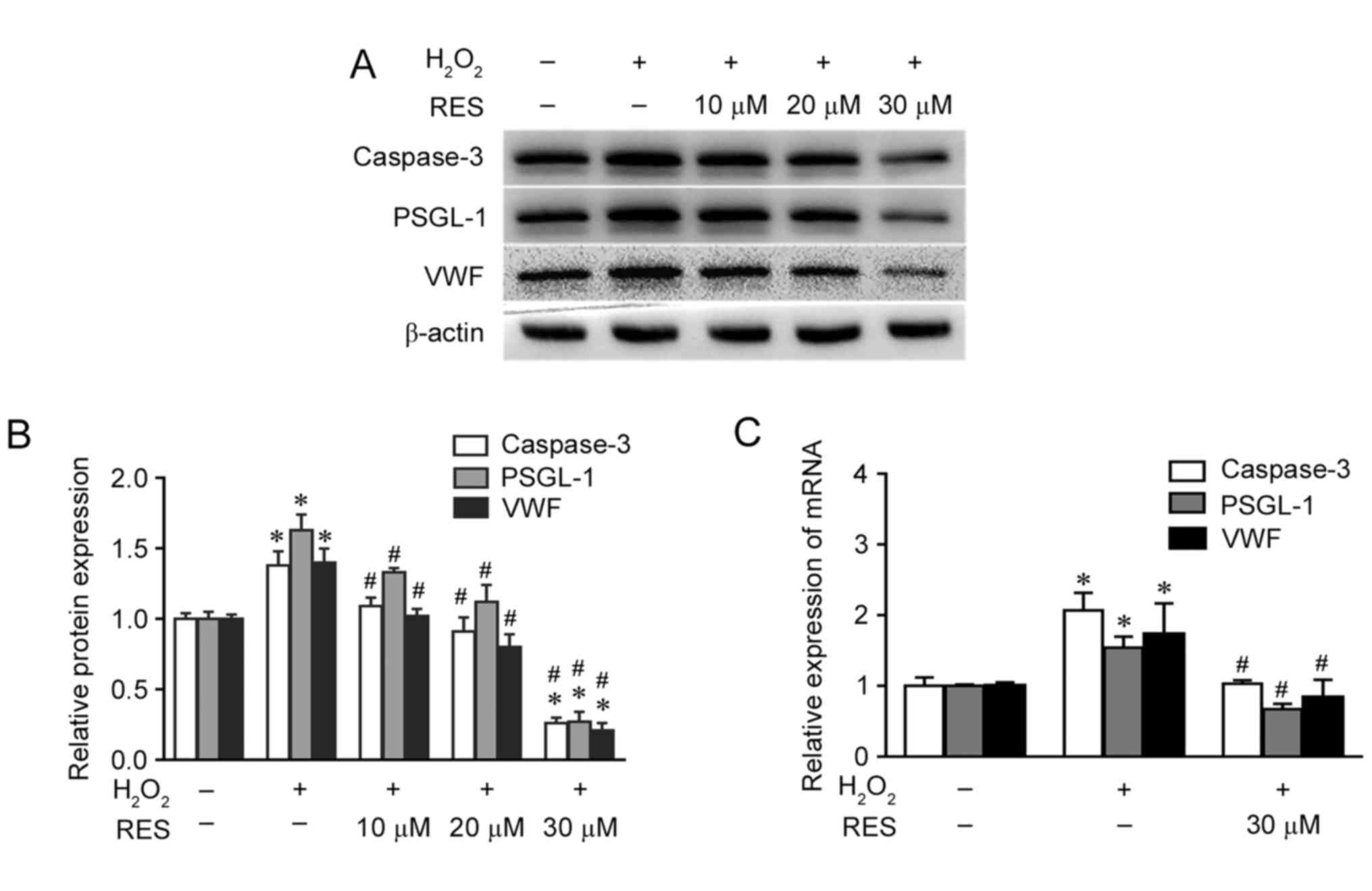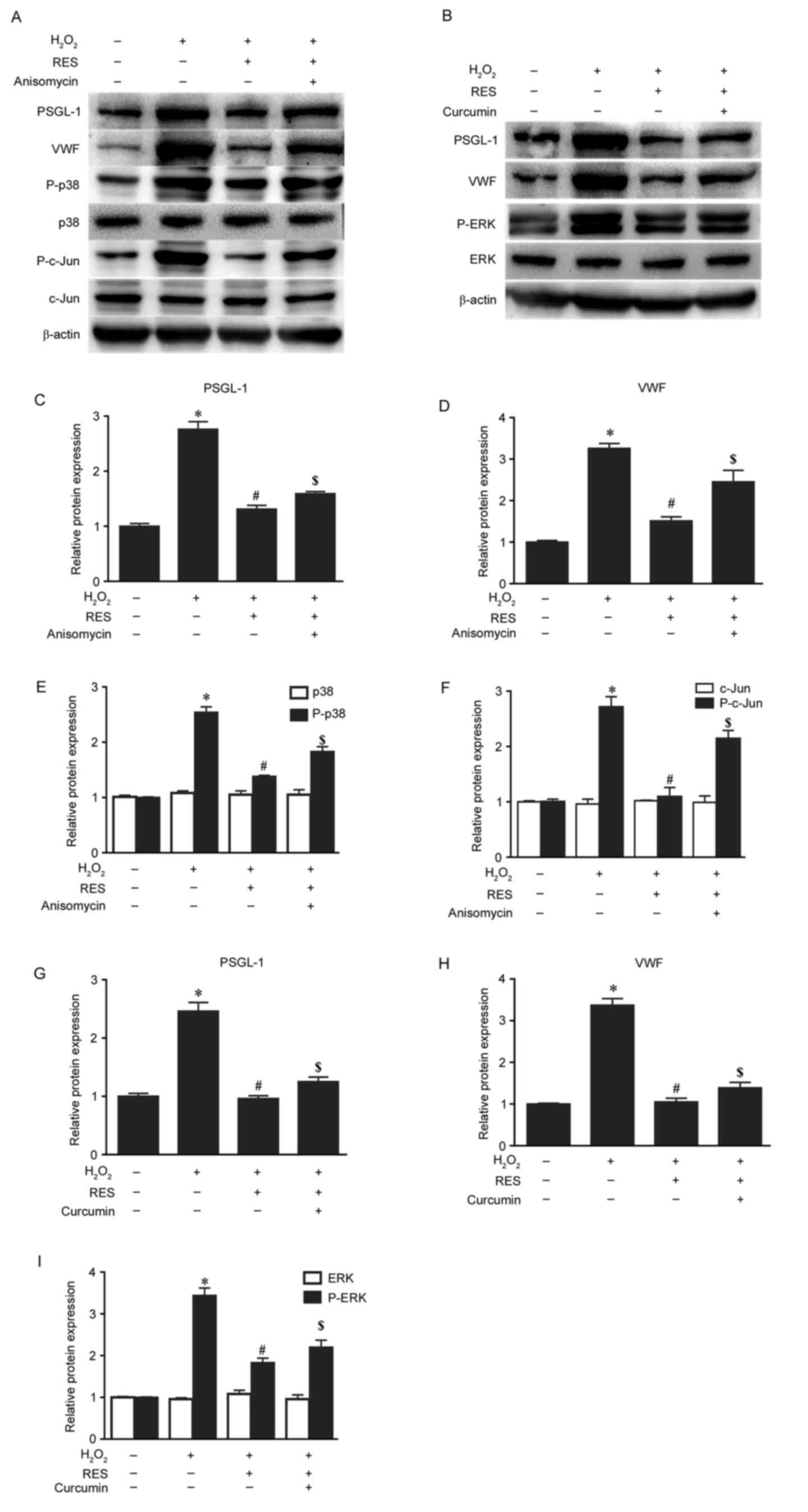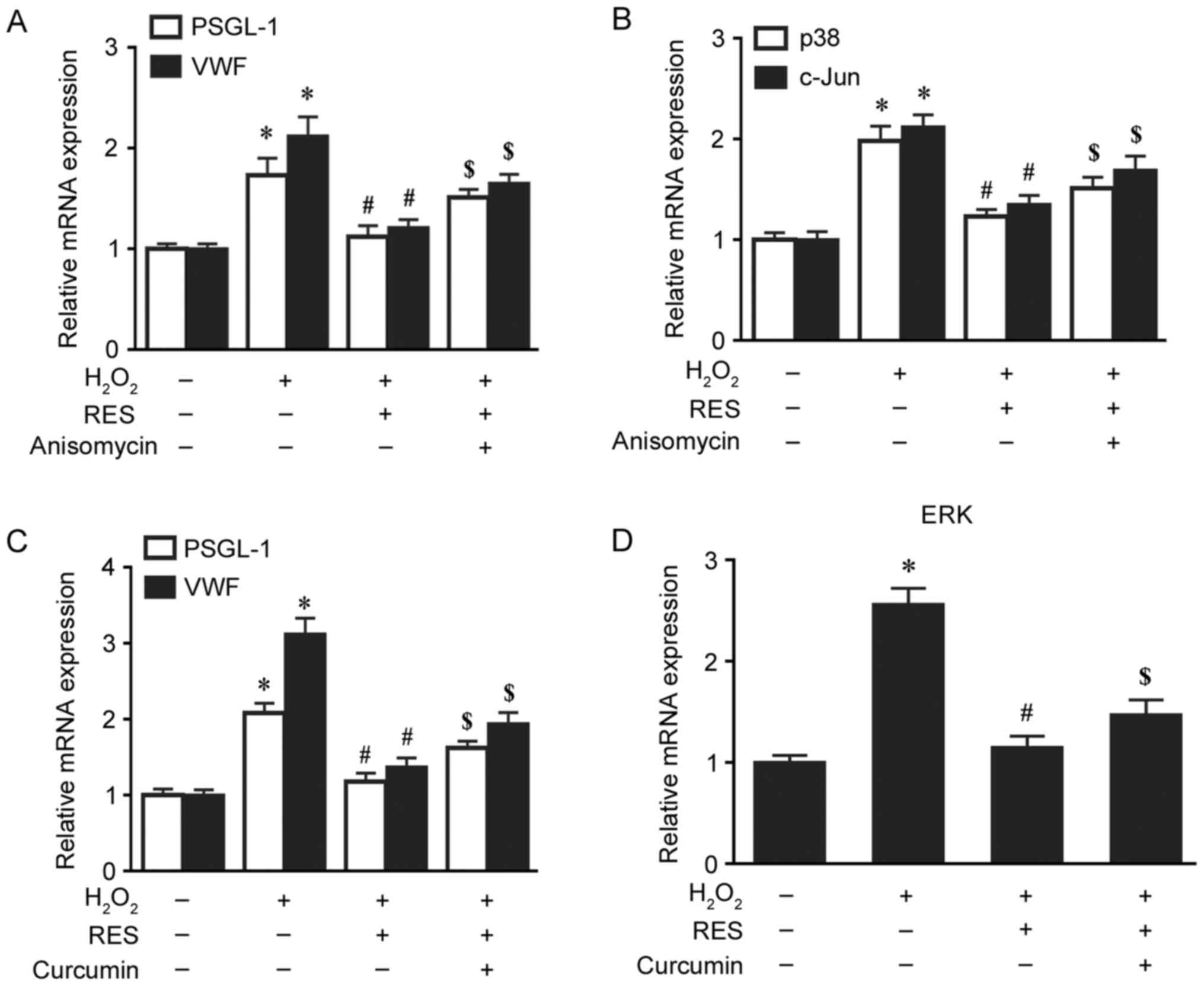Resveratrol attenuates hydrogen peroxide‑induced apoptosis, reactive oxygen species generation, and PSGL‑1 and VWF activation in human umbilical vein endothelial cells, potentially via MAPK signalling pathways
- Authors:
- Published online on: November 21, 2017 https://doi.org/10.3892/mmr.2017.8124
- Pages: 2479-2487
Abstract
Introduction
Deep venous thrombosis (DVT) is a global health problem that affects 1 in 1,000 individuals according to epidemiological studies (1). Even with preventive measures, the incidence of DVT ranges from 2.22–3.29% among patients undergoing major orthopaedic surgeries in developed countries (2,3). Pulmonary embolism, the most dangerous compilation of DVT, affects between 500,000 and 700,000 patients, which may cause mortality in 10–15% of these patients (4). Structural and functional disorders of venous endothelial cells (ECs) have an initial role in the pathogenesis and progression of DVT (5). Currently, oxidative stress injury, which occurs during hypoxia, sepsis and ischaemia-reperfusion injury, is considered to lead to EC dysfunction and initiation of the coagulation cascade (6,7). Excessive levels of reactive oxygen species (ROS) cause oxidative damage to ECs and subsequently activate platelets and leukocytes, increasing their adhesion and aggregation ability and triggering procoagulant reactions (8,9). Therefore, the hypothesis of adopting antioxidants to prevent vascular embolism diseases has been proposed and proven effective in several studies (10–12).
Resveratrol (trans-3,4,5-trihydroxystilbene), a natural, plant-derived polyphenolic compound that is abundant in grape skin, peanuts, mulberries and red wine, has been proven to exhibit a wide range of pharmacological activities, including antioxidant activity, lipoprotein metabolism modulation, anti-platelet aggregation, and anti-inflammatory and anti-tumour effects (13). In addition, cardioprotective activities of resveratrol have previously been identified, however, studies have primarily focused on cardiac and arterial diseases (14,15). Whether resveratrol may exhibit inhibitory effects on venous thrombosis remains largely unknown. Pathways that have previously been associated with the effects of resveratrol treatment include AMP-activated protein kinase, phosphatidylinositol 3-kinase/Akt and sirtuin 1 (16,17). Extracellular signal-regulated kinase (ERK), c-Jun N-terminal kinase (c-Jun) and p38 mitogen-activated protein kinase (MAPK) are conventional MAPK signalling pathway families that are implicated in various diseases, including tumour growth and haemostasis, among others. Furthermore, MAPK signalling pathways, which promote apoptosis and have roles in venous endothelial oxidative stress injury, have been confirmed as important targets that promote thrombosis by mediating interactions among venous endothelial cells, leukocytes and platelets (18). The present study hypothesises that MAPKs may be involved in mediating the effects of resveratrol on venous thrombosis. In addition, von Willebrand factor (VWF) and P-selectin glycoprotein ligand-1 (PSGL-1) are considered thrombotic risk markers, with increases in these factors indicating a thrombotic phenotype (19,20). Therefore, the present study investigated VWF and PSGL-1 levels in HUVECs following different treatments.
The present study aimed to investigate the effects of resveratrol on apoptosis, ROS generation and the expression of thrombosis-associated markers (VWF and PSGL-1) induced by hydrogen peroxide (H2O2) in addition to the underlying mechanisms, in vitro. The results of the present study indicated that resveratrol may exert antithrombotic activity in vitro by inactivating MAPK signalling pathways.
Materials and methods
Reagents, chemicals and antibodies
Primary human umbilical vein endothelial cells (HUVECs) were purchased from CHI Scientific, Inc. (Maynard, MA, USA). High-glucose Dulbecco's modified Eagle's medium (DMEM) and fetal bovine serum (FBS) were both purchased from Hyclone (GE Healthcare Life Sciences, Logan, UT, USA). Resveratrol (purity >99.0%) was purchased from Tokyo Chemical Industry Co., Ltd. (Tokyo, Japan). All primary antibodies were purchased from Proteintech Group, Inc. (Chicago, IL, USA). Phosphorylated antibodies were purchased from ABclonal, Inc. (Cambridge, MA, USA). Anisomycin and curcumin were purchased from Beijing TOP Science Biotechnology Co., Ltd. (Beijing, China). The MTT kit, dimethyl sulphoxide (DMSO), and 2′,7′-dichlorofluorescin diacetate (DCFH-DA) were purchased from Sigma-Aldrich; Merck KGaA (Darmstadt, Germany). The Annexin V-fluorescein isothiocyanate (FITC)/propidium iodide (PI) double-staining Apoptosis Detection kit was obtained from Beyotime Institute of Biotechnology (Haimen, China). Reverse transcription-quantitative polymerase chain reaction (RT-qPCR) primers were synthesized by Sangon Biotech Co., Ltd. (Shanghai, China).
Cell culture and treatments
HUVECs were cultured in DMEM medium supplemented with 10% FBS, 100 U/ml penicillin and 100 µg/ml streptomycin. Cells were maintained at 37°C with 5% CO2 in a humidified atmosphere. Cells were digested with 0.25% trypsin, centrifuged and harvested in a centrifuge (150 × g at room temperature for 5 min) and resuspended in DMEM medium. The cell concentration was adjusted to 1×104 cells/ml and cells were inoculated into a culture flask. The resveratrol solution was prepared in DMSO and diluted with culture medium immediately prior to use. DMSO was used as the control group. The cells were pretreated at 37°C with resveratrol (0, 10, 20 and 30 µM) for 2 h and were then subjected to H2O2 (200 µM) for 24 h. In addition, in the MTT assay, one group received treatment with 30 µM resveratrol without H2O2 treatment. Control cells were treated with medium alone. After the treatments were performed, the cells were harvested for further analysis.
Analysis of cell viability
The viability of HUVECs treated with 0, 10, 20 and 30 µM resveratrol for 2 h followed by treatment with or without 200 µM H2O2 for 24 h was assessed with an MTT assay. After cells were treated and washed with PBS, 10 µl MTT solution (5 mg/ml) was added to the cells. The samples were incubated for 4 h at 37°C and 100 µl dimethyl sulfoxide was added to each well to dissolve the formazan crystals for 4 h at 37°C. The plates were read at 570 nm using a microplate reader (Bio-Rad Laboratories, Inc., Hercules, CA, USA) and the cell viability was expressed as the optical density (OD) value.
Cellular apoptosis assay
HUVECs that were treated with 0, 10, 20 and 30 µM resveratrol for 2 h followed by treatment with or without H2O2 for 24 h were double stained using an Annexin V-FITC/PI Apoptosis Detection kit, according to the manufacturer's instructions. Briefly, the cells were washed and collected in a 1.5 ml tube, 1×105-1×106 cells were resuspended in 300 µl 1X binding buffer and cells were transferred to a sterile flow cytometry glass tube. Annexin V-FITC (5 µl) was added and the tubes were incubated in the dark for 30 min at room temperature. Subsequently, cells were incubated in the dark with 5 µl PI at room temperature for 15 min and analysed with a flow cytometer (Sysmex Partec GmbH, Gorlitz, Germany) and FloMax® software version 2.7 (Sysmex Partec GmbH).
Measurement of intracellular ROS
Intracellular ROS levels were evaluated using the DCFH-DA fluorescent probe reagent and a flow cytometer, according to the manufacturer's instructions. Briefly, after cells (1×105) were seeded in 6-well plates and treated with 0, 10, 20 and 30 µM resveratrol for 2 h followed by treatment with or without H2O2 for 24 h, the cells were washed with PBS and incubated with DCFH-DA (10 µM) in DMEM medium without FBS at 37°C for 20 min. Following incubation, the cellular 2′7′-dichlorofluorescein (DCF) green fluorescence in each well was subsequently imaged at 488 nm using a fluorescence microscope at ×200 magnification (Olympus Corporation, Tokyo, Japan), and DCF fluorescence was quantified using Image-Pro Plus 6 software (Media Cybernetics, Inc., Rockville, MD, USA). Subsequently, flow cytometry (Sysmex Partec GmbH) and FloMax® software version 2.7 (Sysmex Partec GmbH) was also performed to quantify DCF fluorescence and measure ROS generation.
Western blot analysis
Cells were treated at 37°C with 0, 10, 20 and 30 µM resveratrol for 2 h followed by treatment with or without H2O2 for 24 h. For experiments including anisomycin/curcumin treatment, cells were treated with resveratrol (0 and 30 µM) for 2 h followed by treatment with or without anisomycin (0.4 µg/ml for 6 h) or curcumin (25 µM for 4 h) prior to treatment with 200 µM H2O2 for 24 h. Cells were homogenized in radioimminoprecipitation assay buffer (Beyotime Institute of Biotechnology). The lysates were centrifuged (10,625 × g at room temperature for 5 min) and the protein supernatant was collected. Protein concentrations were determined using a BCA Protein assay kit (Beyotime Institute of Biotechnology). The proteins (30 µg) were separated by 10% SDS-PAGE and transferred to nitrocellulose membranes. The membranes were blocked with 5% nonfat dry milk in Tris-buffered saline and 0.1% Tween-20 (TBS-T, pH 7.6) at room temperature for 2 h and probed with antibodies (at 1:1,000) against phosphorylated (p)-p38 MAPK (cat. no. AP0297), p38 MAPK (cat. no. 14064-1-AP), P-c-Jun (cat. no. AP0048), c-Jun (cat. no. 24909-1-AP), P-ERK (cat. no. AP0472), ERK (cat. no. 16443-1-AP), PSGL-1 (cat. no. 23605-1-AP), VWF (cat. no. 11778-1-AP), caspase-3 (cat. no. 19677-1-AP) and β-actin (cat. no. 60008-1-AP) at 4°C overnight. The membranes were washed with TBS-T and hybridized with secondary goat anti-mouse (cat. no. sc-2039) or goat anti-rabbit (cat. no. sc-2007) horse radish peroxidase antibodies at 1:2,000 dilution (Santa Cruz Biotechnology, Inc., Dallas, TX, USA) for 2 h at room temperature and washed again with TBS-T. The protein bands were developed using an ECL Western Blotting substrate (Pierce; Thermo Fisher Scientific, Inc., Waltham, MA, USA) and exposed to autoradiography film (Bio-Rad Laboratories, Inc.) for visualization of the bands. β-actin was used as a loading control. The results were quantified using ImageJ software version 1.48 (National Institutes of Health, Bethesda, MD, USA). The results for the control group were defined as 100%.
RT-qPCR assay
Cells were treated at 37°C with resveratrol (0 and 30 µM) for 2 h followed by treatment with or without 200 µM H2O2 for 24 h. For experiments including anisomycin/curcumin treatment, cellswere treated with resveratrol (0 and 30 µM) for 2 h followed by treatment with or without anisomycin (0.4 µg/ml for 6 h) or curcumin (25 µM for 4 h) prior to treatment with 200 µM H2O2 for 24 h. Total RNA was isolated from HUVECs using TRIzol reagent (Takara Biotechnology Co., Ltd., Dalian, China) according to the manufacturer's instructions. The integrity of the RNA samples was evaluated using agarose gel electrophoresis. Total RNA was reverse transcribed into cDNA using an PrimeScript™ RT Master mix kit, followed by SYBR® Premix Ex Taq™ II (both from Takara Biotechnology Co., Ltd.) to detect the expression levels. β-actin was used as an internal control. The thermocycling conditions were as follows: Thirty seconds at 95°C for the activation of Taq DNA polymerase, followed by 40 cycles of amplification at 95°C for 15 sec and 60°C for 1 min. The reactions were performed in triplicate. The specific primers used for qPCR were as follows: Caspase-3, 5′-GGGCCTGTTGAACTGAAAAA-3′ (forward) and 5′-CCGTCCTTTGAATTTCTCCA-3′ (reverse); PSGL-1, 5′-ATGATTTCCTGCCAGAAACG-3′ (forward) and 5′-GTGGTCAGCTCTGTGACTGC-3′ (reverse); VWF, 5′-TCCTCCTACTCTGCCCCCC-3′ (forward) and 5′-TCCATCCGCTGAATCACCTC-3′ (reverse); β-actin, 5′-ACGGCAAGTTCAACGGCACAG-3′ (forward) and 5′-GACGCCAGTAGACTCCACGACA-3′ (reverse); p38, 5′-GGGGCAGATCTGAACAACAT-3′ (forward) and 5′-CAGGAGCCCTGTACCACCTA-3′ (reverse); ERK, 5′-TGATCACACAGGGTTCCTGA-3′ (forward) and 5′-TGGAAAGATGGGCCTGTTAG-3′ (reverse); and c-Jun, 5′-ACAGAGCATGACCCTGAACC-3′ (forward) and 5′-CCATTFCTGGACTGGATTAT-3′ (reverse). Gene expression values were calculated and normalized to β-actin expression using the 2−ΔΔCq relative expression method (21).
Statistical analysis
Data are presented as the mean ± standard deviation. Group comparisons were assessed using one-way analysis of variance followed by Tukey's post hoc test using GraphPad Prism 5.0a (GraphPad Software, Inc., La Jolla, CA, USA). P<0.05 was considered to indicate a statistically significant difference.
Results
Resveratrol protects HUVECs from H2O2-induced injury
HUVECs were pretreated with resveratrol for 2 h and incubated with H2O2 for 24 h, and cell viability was measured with an MTT assay. The viability of cells was decreased significantly by treatment with 200 µM H2O2 for 24 h, compared with the control group (P<0.05; Fig. 1), while resveratrol protected cells from H2O2-induced injury in a concentration-dependent manner (10 µM, 0.55±0.03 OD; 20 µM, 0.71±0.02 OD; and 30 µM, 0.88±0.04 OD; Fig. 1). Resveratrol significantly enhanced cell viability at 20 and 30 µM compared with the H2O2 only group (P<0.05), while resveratrol treatment alone exhibited no cytotoxicity compared with the control group (P>0.05). These results indicate that resveratrol may protect HUVECs from H2O2-induced injury/death.
Resveratrol attenuates H2O2-induced ROS production in HUVECs
ROS are considered indicators of the cellular oxidative stress state. Therefore, intracellular ROS accumulation was determined by measuring DCF-derived fluorescence with the DCFH-DA probe. The results demonstrated that H2O2 significantly increased ROS levels compared with the control group (P<0.05) and that resveratrol significantly decreased ROS levels in a concentration-dependent manner compared with the H2O2 only group (Fig. 2A-F). The DCF fluorescence quantification results obtained by flow cytometry and presented in Fig. 2G-L were consistent with the micrographs. These results indicate that resveratrol may attenuate H2O2-induced ROS production and oxidative stress in HUVECs.
Resveratrol reduces H2O2-induced apoptosis in HUVECs
To quantitatively investigate the anti-apoptotic effects of resveratrol in H2O2-treated HUVECs, cell apoptosis was measured by Annexin V/PI staining. Quadrants 2 and 4 were considered to indicate apoptotic cells. As demonstrated in Fig. 3, HUVEC apoptosis increased to 34.19±1.8% (P<0.05 vs. control group) when exposed to H2O2. By contrast, increasing doses of resveratrol clearly reduced the apoptosis of HUVECs to 20.24±1.95, 10.93±0.77 and 1.03±0.05% (P<0.05 vs. H2O2 only group). These results indicate that resveratrol may prevent apoptosis induced by H2O2.
Resveratrol inhibits the activation of caspase-3, PSGL-1 and VWF induced by H2O2
Caspase-3 is a key mediator of cell death and an executioner for the death programme in cells in response to H2O2. PSGL-1 and VWF are markers of a prothrombotic status and predict the occurrence of thrombosis. As demonstrated in Fig. 4A and B by western blotting results, the protein expression of caspase-3 was significantly increased by H2O2 treatment compared with the control group (P<0.05). However, when cells were pretreated with resveratrol for 2 h prior to incubation with H2O2, caspase-3 protein expression was significantly decreased in a concentration-dependent manner compared with the H2O2 only group (P<0.05). The protein levels of PSGL-1 and VWF were also significantly increased by H2O2 compared with the control group (P<0.05), while PSGL-1 and VWF protein expression was significantly decreased by resveratrol pretreatment in a concentration-dependent manner compared with the H2O2 only group (P<0.05; Fig. 4A and B). The results for the mRNA levels of caspase-3, PSGL-1 and VWF were similar to those observed for protein levels, although only a resveratrol concentration of 30 µM was used (Fig. 4C).
Resveratrol suppresses the activation of PSGL-1 and VWF via MAPK signalling pathways
To investigate the underlying mechanisms of the effects of resveratrol on thrombosis-associated markers, the present study also detected the expression of MAPK signalling pathway-associated proteins and mRNA by western blotting and RT-qPCR, respectively. The mRNA levels of p38, ERK and c-Jun, and the protein levels of p-p38, P-ERK and P-c-Jun, were significantly increased by H2O2 compared with the control group (P<0.05; Figs. 5 and 6). However, these increases were significantly decreased by pretreatment with 30 µM resveratrol (P<0.05; Figs. 5 and 6). When HUVECs were exposed to anisomycin (0.4 µg/ml for 6 h), an activator of p38 and c-Jun, or curcumin (25 µM for 4 h), an activator of ERK, following treatment with resveratrol, the suppressive effects of resveratrol on PSGL-1 and VWF protein and mRNA expression were attenuated (P<0.05 vs. the H2O2 + resveratrol group; Figs. 5 and 6). In addition, anisomycin or curcumin treatment also significantly attenuated the effects of resveratrol treatment on the mRNA expression of p38, ERK and c-Jun, and the protein levels of p-p38, p-ERK and p-c-Jun (P<0.05 vs. the H2O2 + resveratrol group; Figs. 5 and 6). However, no significant differences were observed in the expression of total p38, ERK and c-Jun protein expression among the different groups (Fig. 5). These results indicate that resveratrol may suppress the activation of PSGL-1 and VWF induced by H2O2 via MAPK signalling pathways.
Discussion
DVT is a common postoperative complication following high-energy trauma that leads to localized clot (thrombus) formation within a femoral or popliteal vein. Venous ECs, platelets and leukocytes have crucial roles in regulating the local microenvironmental balance between coagulation and anticoagulation. Under normal physiological conditions, ECs maintain a vasodilatory and local fibrinolytic state, in which the coagulation, adhesion and activation of platelets and leukocytes is suppressed (22). Oxidative stress, defined as the excessive production of ROS and reactive nitrogen species, has been implicated in numerous diseases, including venous thrombosis. Under pathological conditions, excess ROS production is induced by venous stasis and hypoxia, which destroys endothelial structure and function, promotes procoagulation reactions by upregulating cell adhesion molecules (VWF and PSGL-1), inflammatory cytokines and antifibrinolytic substances (plasminogen activator inhibitor-1), and downregulates anticoagulants and fibrinolytic substances (23,24).
Resveratrol, a potent antioxidant, was recently determined to suppress oxidative stress and decrease ROS generation; the study by Pan et al (25) demonstrated that resveratrol suppressed tumour necrosis factor-α-triggered ROS generation in HUVECs. Additionally, Zhou et al (26) reported that resveratrol pretreatment significantly attenuated the detrimental effect of tert-butyl hydroperoxide on cell viability and apoptosis by inhibiting mitochondrial ROS generation in HUVECs. In addition, Zhang et al (27) reported that the effects of vinorelbine on cell apoptosis, intracellular ROS generation and intracellular superoxide dismutase activity were attenuated when ECV-304 human vascular endothelial cells were pretreated with resveratrol. To confirm these studies, in the present study, HUVECs were pretreated with resveratrol for 2 h and incubated with H2O2 for 24 h. HUVEC viability was decreased significantly by H2O2, one of the major components of ROS. In addition, resveratrol protected cells from H2O2-induced cytotoxicity in a concentration-dependent manner, as demonstrated in Fig. 1. Furthermore, resveratrol significantly decreased ROS levels and clearly attenuated H2O2-induced apoptosis, as presented in Figs. 2 and 3. As sufficient evidence indicates that resveratrol may suppress oxidative stress and decrease ROS generation, resveratrol may have potential in the prevention of DVT.
VWF, which is produced by megakaryocytes and ECs, is a multimeric glycoprotein that is expressed in the subendothelial matrix, blood plasma, platelets and endothelium (28). VWF binds to exposed subendothelial collagen rapidly upon damage to the vascular surface and triggers a complex pathway, including platelet activation, adhesion and aggregation (29). PSGL-1 is a glycoprotein that was originally identified in leukocytes as the ligand of P-selectin and has an important role in the selective recruitment of leukocytes and activated platelets into the venous wall, which amplifies the coagulation cascade and results in increased thrombin generation (30,31). Consequently, VWF and PSGL-1 are referred to as thrombosis-associated markers, and increased levels of these markers in the plasma predicts the occurrence of thrombosis (20,32). To validate the inhibitory effect of resveratrol on DVT in vitro, the present study investigated the effect of resveratrol on VWF and PSGL-1 in HUVECs. The results demonstrated that VWF and PSGL-1 secretion from the HUVECs was stimulated by H2O2, while resveratrol markedly decreased VWF and PSGL-1 elevation in a concentration-dependent manner, as demonstrated in Fig. 4. To the best of our knowledge, the present study is the first to investigate the effect of resveratrol on thrombosis-associated markers, and the results indicate that resveratrol may inhibit venous thrombosis by suppressing VWF and PSGL-1. However, it should be noted that this conclusion is only based on in vitro experiments and at the molecular level. Follow-up animal studies are required to confirm this hypothesis.
Various studies have reported that MAPK pathways contribute to vascular endothelial oxidative stress and venous thrombosis. The expression and secretion of VWF via the activation of ERK was blocked by inhibitors of ERK in HUVECs (33). Venous thrombosis triggered by PSGL-1 and P-selectin was reported to depend on MAPK signalling pathways (34). In the present study, the results demonstrated that H2O2 (200 µM) induced upregulation of mRNA and protein phosphorylation levels of p38, ERK and c-Jun in HUVECs, and resveratrol downregulated these effects at the mRNA and protein phosphorylation levels. When HUVECs were pretreated with the MAPK activators anisomycin and curcumin, the suppressive effects of resveratrol on PSGL-1 and VWF were attenuated, as demonstrated in Figs. 5 and 6. A studies reported that MAPKs cascades were maximally activated within 10–20 min after treatment with numerous stimuli (35). To investigate the simultaneous alterations in MAPKs with PSGL-1 and VWF, levels of p-p38, P-ERK and p-c-Jun were assayed after treatment with H2O2 for 24 h. Due to this discrepancy and limitation of the present study, MAPK pathways should be assayed within 20 min to validate the results of the present study.
The results of the present study indicated that resveratrol may inhibit the activation of VWF and PSGL-1 via MAPK pathways. However, regarding the development of venous thrombosis, the underlying molecular mechanisms regulating the expression of VWF and PSGL-1 is complex and requires further investigation. In conclusion, these findings demonstrate that resveratrol may protect HUVECs from oxidative stress and apoptosis, and suppress the expression of thrombosis-associated markers, by inactivating MAPK signalling pathways.
Acknowledgements
The present study was funded by the National Natural Science Foundation of China (grant no. 81160236) and the Health Science and Technology Project of Yunnan province (grant nos. 2014NS142 and 2017NS022).
Glossary
Abbreviations
Abbreviations:
|
DVT |
deep venous thrombosis |
|
ROS |
reactive oxygen species |
|
HUVECs |
human umbilical vein endothelial cells |
|
ECs |
endothelial cells |
|
ERK |
extracellular signal-regulated kinase |
|
c-Jun |
c-Jun N-terminal kinase |
|
MAPK |
mitogen-activated protein kinase |
|
VWF |
von Willebrand factor |
|
PSGL-1 |
P-selectin glycoprotein ligand-1 |
References
|
Ashrani AA and Heit JA: Incidence and cost burden of post-thrombotic syndrome. J Thromb Thrombolysis. 28:465–476. 2009. View Article : Google Scholar : PubMed/NCBI | |
|
Dixon J, Ahn E, Zhou L, Lim R, Simpson D and Merriman EG: Venous thromboembolism rates in patients undergoing major hip and knee joint surgery at waitemata district health board: A retrospective audit. Intern Med J. 45:416–422. 2015. View Article : Google Scholar : PubMed/NCBI | |
|
Cha SI, Lee SY, Kim CH, Park JY, Jung TH, Yi JH, Lee J, Huh S, Lee HJ and Kim SY: Venous thromboembolism in Korean patients undergoing major orthopedic surgery: A prospective observational study using computed tomographic (CT) pulmonary angiography and indirect CT venography. J Korean Med Sci. 25:28–34. 2010. View Article : Google Scholar : PubMed/NCBI | |
|
Ho KM, Burrell M, Rao S and Baker R: Incidence and risk factors for fatal pulmonary embolism after major trauma: A nested cohort study. Br J Anaesth. 105:596–602. 2010. View Article : Google Scholar : PubMed/NCBI | |
|
López JA and Chen J: Pathophysiology of venous thrombosis. Thromb Res. 123 Suppl 4:S30–S34. 2009. View Article : Google Scholar | |
|
Kim YW and Byzova TV: Oxidative stress in angiogenesis and vascular disease. Blood. 123:625–631. 2014. View Article : Google Scholar : PubMed/NCBI | |
|
Ekim M, Sekeroglu MR, Balahoroglu R, Ozkol H and Ekim H: Roles of the oxidative stress and ADMA in the development of deep venous thrombosis. Biochem Res Int. 2014:7031282014. View Article : Google Scholar : PubMed/NCBI | |
|
Fan LM, Douglas G, Bendall JK, McNeill E, Crabtree MJ, Hale AB, Mai A, Li JM, McAteer MA, Schneider JE, et al: Endothelial cell-specific reactive oxygen species production increases susceptibility to aortic dissection. Circulation. 129:2661–2672. 2014. View Article : Google Scholar : PubMed/NCBI | |
|
Zeng M, Wei X, Wu Z, Li W, Li B, Fei Y, He Y, Chen J, Wang P and Liu X: Reactive oxygen species contribute to simulated ischemia/reperfusion-induced autophagic cell death in human umbilical vein endothelial cells. Med Sci Monit. 20:1017–1023. 2014. View Article : Google Scholar : PubMed/NCBI | |
|
Yang Y, Duan W, Liang Z, Yi W, Yan J, Wang N, Li Y, Chen W, Yu S, Jin Z and Yi D: Curcumin attenuates endothelial cell oxidative stress injury through Notch signaling inhibition. Cell Signal. 25:615–629. 2013. View Article : Google Scholar : PubMed/NCBI | |
|
Kostyuk VA, Potapovich AI, Suhan TO, de Luca C and Korkina LG: Antioxidant and signal modulation properties of plant polyphenols in controlling vascular inflammation. Eur J Pharmacol. 658:248–256. 2011. View Article : Google Scholar : PubMed/NCBI | |
|
Csiszár A, Csiszar A, Pinto JT, Gautam T, Kleusch C, Hoffmann B, Tucsek Z, Toth P, Sonntag WE and Ungvari Z: Resveratrol encapsulated in novel fusogenic liposomes activates Nrf2 and attenuates oxidative stress in cerebromicrovascular endothelial cells from aged rats. J Gerontol A Biol Sci Med Sci. 70:303–313. 2015. View Article : Google Scholar : PubMed/NCBI | |
|
Brisdelli F, D'Andrea G and Bozzi A: Resveratrol: A natural polyphenol with multiple chemopreventive properties. Curr Drug Metab. 10:530–546. 2009. View Article : Google Scholar : PubMed/NCBI | |
|
Guo H, Chen Y, Liao L and Wu W: Resveratrol protects HUVECs from oxidized-LDL induced oxidative damage by autophagy upregulation via the AMPK/SIRT1 pathway. Cardiovasc Drugs Ther. 27:189–198. 2013. View Article : Google Scholar : PubMed/NCBI | |
|
Hu YX, Cui H, Fan L, Pan XJ, Wu JH, Shi SZ, Cui SY, Wei ZM and Liu L: Resveratrol attenuates left ventricular remodeling in old rats with COPD induced by cigarette smoke exposure and LPS instillation. Can J Physiol Pharmacol. 91:1044–1054. 2013. View Article : Google Scholar : PubMed/NCBI | |
|
Lan F, Weikel KA, Cacicedo JM and Ido Y: Resveratrol-induced AMP-Activated protein kinase activation is cell-type dependent: Lessons from basic research for clinical application. Nutrients. 9:E7512017. View Article : Google Scholar : PubMed/NCBI | |
|
Abdel-Aleem GA, Khaleel EF, Mostafa DG and Elberier LK: Neuroprotective effect of resveratrol against brain ischemia reperfusion injury in rats entails reduction of DJ-1 protein expression and activation of PI3K/Akt/gsk3b survival pathway. Arh Physiol Biochem. 122:200–213. 2016. View Article : Google Scholar | |
|
Adam F, Kauskot A, Rosa JP and Bryckaert M: Mitogen-activated protein kinases in hemostasis and thrombosis. J Thromb Haemost. 6:2007–2016. 2008. View Article : Google Scholar : PubMed/NCBI | |
|
Lazzari MA, Sanchez-Luceros A, Woods AI, Alberto MF and Meschengieser SS: Von Willebrand factor (VWF) as a risk factor for bleeding and thrombosis. Hematology. 17 Suppl 1:S150–S152. 2012.PubMed/NCBI | |
|
Miszti-Blasius K, Debreceni IB, Felszeghy S, Dezso B and Kappelmayer J: Lack of P-selectin glycoprotein ligand-1 protects mice from thrombosis after collagen/epinephrine challenge. Thromb Res. 127:228–234. 2011. View Article : Google Scholar : PubMed/NCBI | |
|
Livak KJ and Schmittgen TD: Analysis of relative gene expression data using real-time quantitative PCR and the 2(-Delta Delta C(T)) Method. Methods. 25:402–408. 2001. View Article : Google Scholar : PubMed/NCBI | |
|
Bertina RM: The role of procoagulants and anticoagulants in the development of venous thromboembolism. Thromb Res. 123 Suppl 4:S41–S45. 2009. View Article : Google Scholar : PubMed/NCBI | |
|
Violi F and Pignatelli P: Platelet oxidative stress and thrombosis. Thromb Res. 129:378–381. 2012. View Article : Google Scholar : PubMed/NCBI | |
|
Wakefield TW, Myers DD and Henke PK: Role of selectins and fibrinolysis in VTE. Thromb Res. 123 Suppl 4:S35–S40. 2009. View Article : Google Scholar : PubMed/NCBI | |
|
Pan W, Yu H, Huang S and Zhu P: Resveratrol protects against TNF-α-induced injury in human umbilical endothelial cells through promoting sirtuin-1-induced repression of NF-KB and p38 MAPK. PLoS One. 11:e01470342016. View Article : Google Scholar : PubMed/NCBI | |
|
Zhou X, Chen M, Zeng X, Yang J, Deng H, Yi L and Mi MT: Resveratrol regulates mitochondrial reactive oxygen species homeostasis through Sirt3 signaling pathway in human vascular endothelial cells. Cell Death Dis. 5:e15762014. View Article : Google Scholar : PubMed/NCBI | |
|
Zhang J, Tong N, Chen Y, Li P, Yang S and Zhao X: Resveratrol protects against vinorelbine-induced vascular endothelial cell injury. Toxicol Mech Methods. 23:665–671. 2013. View Article : Google Scholar : PubMed/NCBI | |
|
Matsui T and Hamako J: von Willebrand factor and von Willebrand disease. Rinsho Ketsueki. 57:2113–2123. 2016.PubMed/NCBI | |
|
Castaman G and Linari S: Human von Willebrand factor/factor VIII concentrates in the management of pediatric patients with von Willebrand disease/hemophilia A. Ther Clin Risk Manag. 12:1029–1037. 2016. View Article : Google Scholar : PubMed/NCBI | |
|
Cerletti C, Tamburrelli C, Izzi B, Gianfagna F and de Gaetano G: Platelet-leukocyte interactions in thrombosis. Thromb Res. 129:263–266. 2012. View Article : Google Scholar : PubMed/NCBI | |
|
Hubert L, Darbousset R, Panicot-Dubois L, Robert S, Sabatier F, Fallague K, Dignat-George F and Dubois C: Neutrophils recruit and activate human endothelial colony-forming cells at the site of vessel injury via P-selectin glycoprotein ligand-1 and L-selectin. J Thromb Haemost. 12:1170–1181. 2014. View Article : Google Scholar : PubMed/NCBI | |
|
Lazzari MA, Sanchez-Luceros A, Woods AI, Alberto MF and Meschengieser SS: Von Willebrand factor (VWF) as a risk factor for bleeding and thrombosis. Hematology. 17 Suppl 1:S150–S152. 2012.PubMed/NCBI | |
|
Wang J, Li H, He J, Li B, Bao Q, Zhang X, Lv Z, Zhang Y, Han J, Ai D and Zhu Y: 20-Hydroxyeicosatetraenoic acid involved in endothelial activation and thrombosis. Am J Physiol Heart Circ Physiol. 308:H1359–H1367. 2015. View Article : Google Scholar : PubMed/NCBI | |
|
Zuchtriegel G, Uhl B, Puhr-Westerheide D, Pörnbacher M, Lauber K, Krombach F and Reichel CA: Platelets guide leukocytes to their sites of extravasation. PLoS Biol. 14:e10024592016. View Article : Google Scholar : PubMed/NCBI | |
|
Gao H, Liu L, Zhao Y, Hara H, Chen P, Xu J, Tang J, Wei L, Li Z, Cooper DK, et al: Human IL-6, IL-7, IL-1β, and TNF-α differently regulate the expression of pro-inflammatary related genes, tissue factor, and swine leukocyte antigen class I in porcine aortic endothelial cells. Xenotransplantation. 24:e122912017. View Article : Google Scholar |



